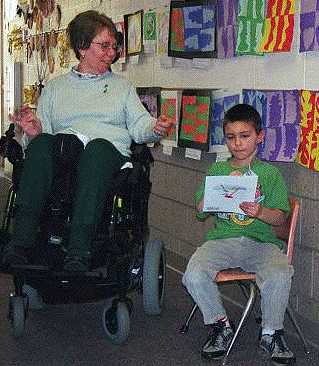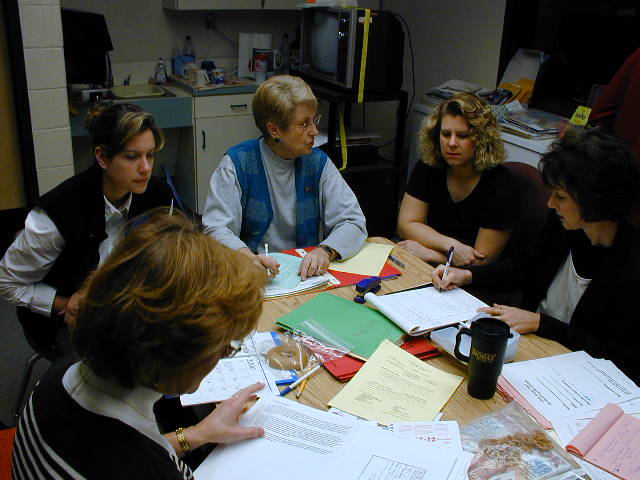 AuSable
Primary School Profile
AuSable
Primary School Profile
306 Plum Street
Grayling, MI 49738
517-348-7641
The Community-
Grayling is located in a rural, beautiful area of the state known for canoeing,
fishing, and other outside sports. The racial make-up of Grayling is fairly homogeneous
with 1,521 whites, 4 blacks, 7 American Indians, and 10 Asians.
The population includes approximately 460 families and about 600
households with a median household income in 1989 of $22, 054.
This is a very small, very rural community of 1,542 people, located
in the upper central part of the lower penninsula in the city
of Grayling in Crawford County
The School-
The school is part of the Crawford-AuSable School District.
The district's mission statement: "The Crawford AuSable School
District, in cooperation with our community, students, families
and staff, will facilitate comprehensive, lifelong, educational
opportunities by addressing individual, community and global needs.".
The district covers a 530-square mile area, and contains one primary,
two elementary, one middle, and one high school. Total district
enrollment for 1997 was 2,264 students.*
AuSable Primary is housed in a new building which opened in
1997. It is connected via hallways to the adjacent upper elementary
building. This is a building-wide Title I school. The district's
Michigan School Readiness Program for four year olds is also housed
in this school.
Principal: Barbara Mick
Students: 430*
% Free/Reduced Lunch: 56%*
Pupil/Teacher Ratio: 22.0/1*
Total Staff: twenty eight certified and twelve non-certified.
 Disabilites:
The district had the following special needs students as of December
1, 1998 -- 35 educable mental impairments, 6 trainable mental
impairments, 10 emotional impairments, 154 learning diabilities,
1 hearing impairment, 1 visual impairment, 12 phyiscal and other
impairments, 1 severe multiple impairment, 77 speech and language
impariments, 6 preprimary impairments, and 4 autism impairments.
This is a district total of 301 students.
Disabilites:
The district had the following special needs students as of December
1, 1998 -- 35 educable mental impairments, 6 trainable mental
impairments, 10 emotional impairments, 154 learning diabilities,
1 hearing impairment, 1 visual impairment, 12 phyiscal and other
impairments, 1 severe multiple impairment, 77 speech and language
impariments, 6 preprimary impairments, and 4 autism impairments.
This is a district total of 301 students.
The building itself is home to 4-6 POHI students, 2 autisitic,
and several EMI, LD students.
School change and Improvement:
Have attempted to mix grade levels in order to provide choice
and "mix everybody up". Took a hard look at the school
and recognized a growing number of kids with disabilities. Developed
a vision of "all our students aare all of ours".
Empowering Citizens in a Democracy-
Weekly assemblies are held to help provide a common vision,
clear goals and a sense of belonging. Lessons have been developed
to promote tolerance and appreciation of diversity. Such lessons
have allowed students to be grouped in different arrangements
and be exposed to differnet educators.
Include All-
One special education teacher and one Title I teacher work
together to provide in-class supports, jointly supervising aides
to the general education teachers. Children with special needs
appeared to be well integrated into center activities.
Authentic Teaching and for Learners of Diverse Abilities.
A staff and principal deeply committed to inclusion through
mutiage and looping programs. Teachers have been trained in multiple
intelligences. Teachers work as a team and plan cooperatively.
In this setting each child is seen as unique with lessons planned
to meet a child where she is. Common planning periods are built
into the schedule help to achieve this. This includes a weekly
one hour block of time for grade-level planning, with each grade
taking one week per month. The special education staff has been
embraced by the regular classroom teachers as co-leaders in the
class. The Chicago Math program appears to not work within this
approach as the children are separated by grade level for math
study. The school has a developmental philosophy to learning-
accepting each child where she is, and getting them ready from
there for the next step using clear, concise benchmarks and outcomes.
Doing a great deal of work with literacy, had been part of
a pilot program- Michigan Literacy Profile. Have looked at and
implemented guided reading and literacy circles. The staff have
also received inservice from leading New Zealand reading persons,
which will be implemented in the 1999-2000 school year.
 Building Community and Supporting Learning-
Building Community and Supporting Learning-
Each classroom is assigned one specialist for support. Through
co-teaching, modeling is provided on how to work with a variety
of special needs
students. A crisis-intervention team was also developed. This
is a specially trained team of six specialists including physical
education teacher, secretary, and one special education paraprofessional.
This was developed for challenging behaviors and classroom disruptions.
Parent Partnerships-
Staff strive to include parents in their child's education
as early as possible, by bridging the gap from the preschool years
to primary with multiple transition activities. There is a monthly
family night, a strong and active Parent Group, and school-to-work
lesson plans which link children back to their community. Principal
has identified a lack of trust between parents and school as a
problem to be addressed. There are also scheduled monthly parent
meeting where learning and fun are mixed. This area seems to be
the staff's greatest challenge and disappointment thus far.
 Disabilites:
The district had the following special needs students as of December
1, 1998 -- 35 educable mental impairments, 6 trainable mental
impairments, 10 emotional impairments, 154 learning diabilities,
1 hearing impairment, 1 visual impairment, 12 phyiscal and other
impairments, 1 severe multiple impairment, 77 speech and language
impariments, 6 preprimary impairments, and 4 autism impairments.
This is a district total of 301 students.
Disabilites:
The district had the following special needs students as of December
1, 1998 -- 35 educable mental impairments, 6 trainable mental
impairments, 10 emotional impairments, 154 learning diabilities,
1 hearing impairment, 1 visual impairment, 12 phyiscal and other
impairments, 1 severe multiple impairment, 77 speech and language
impariments, 6 preprimary impairments, and 4 autism impairments.
This is a district total of 301 students. AuSable
Primary School Profile
AuSable
Primary School Profile Building Community and Supporting Learning-
Building Community and Supporting Learning-